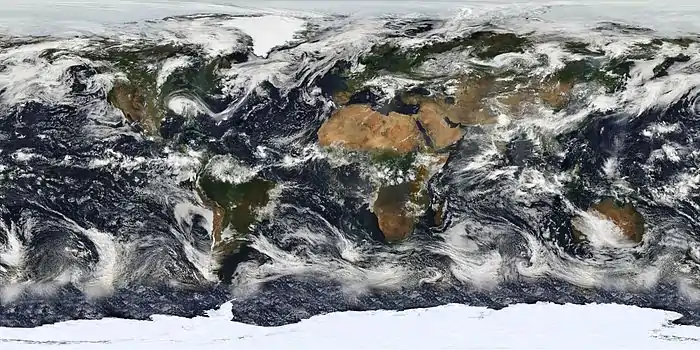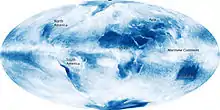Cloud cover
Cloud cover (also known as cloudiness, cloudage, or cloud amount) refers to the fraction of the sky obscured by clouds when observed from a particular location.[1] Okta is the usual unit of measurement of the cloud cover. The cloud cover is correlated to the sunshine duration as the least cloudy locales are the sunniest ones while the cloudiest areas are the least sunny places.



The global cloud cover averages around 0.68 when analyzing clouds with optical depth larger than 0.1. This value is lower (0.56) when considering clouds with an optical depth larger than 2, and higher when counting subvisible cirrus clouds.[2]
Role in the climate system

Clouds play multiple critical roles in the climate system. In particular, being bright objects in the visible part of the solar spectrum, they efficiently reflect light to space and thus contribute to the cooling of the planet. Cloud cover thus plays an important role in the energetic balance of the atmosphere and a variation of it is a consequence of and to the climate change expected by recent studies.[3]
Variability
Cloud cover values only vary by 0.03 from year to year, whereas the local, day to day variability in cloud amount typically rises to 0.3 over the globe. Most data sets agree on the fact that the land is covered by 0.10-0.15 less cloud than the oceans.[2]
Lastly, there is a latitudinal variation in the cloud cover, such that around 20°N there are regions with 0.10 less cloudiness than the global mean. Almost the same variation (0.15 instead of 0.10) is found 20°S. On the other hand, in the storm regions of the Southern Hemisphere midlatitudes were found to have with 0.15-0.25 more cloudiness than the global mean at 60°S.[2] On average, about 52% of Earth is cloud-covered at any moment.[5]
On a continental scale, it can be noticed based upon a long-term satellite recording of cloudiness data that on a year-mean basis, Europe, North America, South America and Asia are dominated by cloudy skies. On the other hand, Africa, the Middle East and Australia are dominated by clear skies.[6]
On a regional scale, it can be also worthy of note that some extensive areas of Earth experience cloudy conditions virtually all time such as South America's Amazon Rainforest while other ones experience clear-sky conditions virtually all time such as Africa's Sahara Desert.[6]
| Part of a series on |
| Weather |
|---|
 |
|
|
References
- Huschke, Ralph E. (1970) [1959]. "Cloud cover". Glossary of Meteorology (2nd ed.). Boston: American Meteorological Society. Retrieved 2013-08-24.
- Stubenrauch, C. J.; Rossow, W. B.; Kinne, S.; Ackerman, S.; Cesana, G.; Chepfer, H; Di Girolamo, L.; Getzewich, B.; Guignard, A.; Heidinger, A.; Maddux, B. C.; Menzel, W.P; Minnis, P.; Pearl, C.; Platnick, S.; Poulsen, C.; Reidi, J.; Sun-Mack, S; Walther, A.; Winker, D.; Zeng, S.; Zhao, G. (2013). "Assessment of global cloud datasets from satellites: Project and Database initiated by GEWEX Radiation Panel" (PDF). Bulletin of the American Meteorological Society. 94 (7): 1031–1049. Bibcode:2013BAMS...94.1031S. doi:10.1175/BAMS-D-12-00117.1.
- IPCC Third Assessment Report Chapter 7. Physical Climate Processes and Feedbacks (Atmospheric Processes and Feedbacks 7.2) (Report). International Panel on Climate Change. Archived from the original on August 5, 2013. Retrieved August 24, 2013.
It has extensive coverage of cloud-climate interactions
- "Cloud Fraction". 2018-10-31.
- National Geographic Almanac of Geography, ISBN 0-7922-3877-X, page 67
- https://images.slideplayer.com/17/5328401/slides/slide_4.jpg
- McIntosh, D. H. (1972) Meteorological Glossary, Her Majesty's Stationery Office, Met. O. 842, A.P. 897, 319 p.
External links
| Wikimedia Commons has media related to Cloud cover. |
- NSDL.arm.gov, Glossary of Atmospheric Terms, From the National Science Digital Library's Atmospheric Visualization Collection.
- Earthobersvatory.nasa.gov, Monthly maps of global cloud cover from NASA's Earth Observatory
- International Satellite Cloud Climatology Project (ISCCP), NASA's data products on their satellite observations
- NASA composite satellite image.
